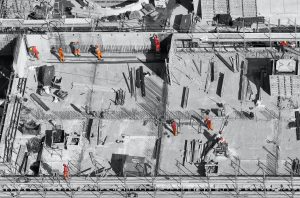R.P.T. Nayanathara, T.L. Dissanayake, Thamasha Jayanetti (Published in IQSSL Focus journal, January 2021)
1. Importance of Contract Administration in construction projects
Contract administration is used to describe the functions performed subsequent to the signing of a contract by the relevant parties (Sherman, 1996). As stated by Pooworakulchai, Kongsong, and Kongbenjapuch (2017), construction contracts specify the rights and duties of the construction stakeholders stating the role of each stakeholder. As the obligations of each stakeholder are stated in the contract, effective contract administration is of high importance (Patel, Patel & Marvadi, 2015). Contract administration involves the activities that ensure the enforcement of contract terms and conditions. During the execution of the contract, attention should be paid to achieving the targeted output of the contract. According to Davison and Sebastian (2009), contract goals are established by first identifying the risks associated with the contract and the problems that may arise during contract administration.
Contract administration in a construction project involves the management of the project contract; the contract administrator is responsible for overseeing the contract. The rights and responsibilities of the different parties involved in the project are established through the contract and the success of the project depends on the intention and the performance of those parties (Kayastha, 2014). The execution of a construction contract of a project is monitored through contract administration to ensure the completion of the project on schedule within the estimated budget.
2. Hindrances to effective Contract Administration
Successful project delivery will be affected by factors that hinder effective contract administration (Rauzana, 2016). Therefore, hindrance factors that have a negative impact on contract administration have to be investigated.Contractor selection, construction changes, and the exclusion of any additional tasks from the contract are identified as the factors that significantly affect contract administration (Pooworakulchai, Kongsong, & Kongbenjapuch, 2017). Patel, Patel, and Marvadi (2015) classified the delays that occur in construction projects as critical, excusable, compensable, and concurrent delays. They have identified cost overruns, time overruns, disputes, negotiations, litigations, and project abandonment as the consequences of these delays and have mentioned that they s often cause problems. Thus, when implementing a construction project, attention should be paid to the factors that have the most adverse impacts on the project.
Delays and disputes are the main causes of contract failures (Patel, Patel & Marvadi, 2015). Mwanaumo et al. (2016) stated that time management has a significant effect on construction projects because it affects the programming, extension, and completion of the projects and the penalties imposed for any delays incurred in the execution of the projects.
In a similar study, Patel, Patel, and Marvadi (2015) stated that in a construction project, variations, alterations, additions, omissions, and unjust enrichments by the clients, would generally result in disputes while documentational and estimation errors also are responsible for disputes. Delays in making decisions during procurement have been identified as a huge problem (Kayastha, 2014). As mentioned by Aibinu (2008), delivery schedule failure is a recurring problem in the construction industry.
According to Akinsiku and Ajayi (2016),improper financial management, inability of the contractors to perform work, failure to select the standard forms of contract, poor coordination of the activities within the project team, and failure of the consultants in recommending the claims are the factors that adversely affect the delivery of construction projects. Chow and Cheung (2008) stated that conflicts in construction projects lead to disputes if not properly handled. While agreeing with Chow and Cheung (2008), Abeynayake (2008) stated that the four main reasons for the disputes in the construction industry in Sri Lanka are the breaching of the contract by a party to the contract; insufficient administration of responsibilities by the parties; specifications and plans containing omissions, errors, and ambiguities; and the sudden increase of taxes and costs. Kayastha (2014) elaborated that the lack of coordination among the parties to a contract has a direct impact on the progress of a construction project because it obstructs the smooth running of the construction activities, thereby hindering the workflow.
3. Strategies that will minimise the effect of hindrance factors
The hindrances of the successful delivery of construction projects need to be eliminated through effective contract administrative practices. Patel, Patel, and Marvadi (2015)identified several techniques and tools for effective contract administration that will ensure successful project delivery, namely using the principles of project management, developing a plan for contract administration, holding pre-performance conferences, observing the project progress, managing the payment process, and managing the dispute resolution process. Thus, effective contract administration is not just one procedure, but also a chain of procedures that should be implemented, monitored, and readjusted flawlessly.
The hindrances of contract administration, the factors that have negative impacts on contract administration, can be mitigated by the timely addressing of their indicators, such as, establishing a clear mechanism to obtain information, establishing proper communication among the team members, enabling proper supervision and proper management of the project (Rauzana, 2016). When a delay occurs, the project completion will have to be accelerated and the required changes made to the schedule. These measures will finally make the project cost to exceed its estimated value (Patel, Patel, & Marvadi, 2015). To mitigate the lack of coordination among the parties to the contract and ensure the smooth implementation of construction projects, Kayastha (2014) stated that the coordination should be done on time and ensure.
Disputes are one of the major factors that obstruct successful project completion. Kayastha (2014)stated thatdisputes could effectively be reduced through unbiased and clear conditions of contract. Record keeping and contract documentation are the important to complete s project as scheduled within the given budget and at the required quality. Record keeping and contract documentation will avoid disputes in construction projects (Mwanaumo et al., 2016). According to Rauzana (2016), the success of a construction project has to be measured in terms of time, cost, and quality. To maintain the cost of a project within the limits specified, the payments should be handled as stated in the agreements and the contract document, to meet the required quality, the works have to be performed to comply with the technical specifications mentioned in the contract document and the agreements. Finally, the project should be completed on time according to the schedule of work given in the contract document (Rauzana, 2016).
4. References
- Abeynayake, M. (2008). Special Features and Experiences of the Construction Industry – Arbitration in Sri Lanka. In Building Resilience,1227-1236.
- Aibinu, A. (2008). Managing Projects to Reduce Delivery Schedule Failures. Building Resilience, 1506-1519.
- Akinsiku, O., & Ajayi, O. (2016). Effects of Delayed Payment of Contractors on Construction Project Delivery in Nigeria. COBRA 2016. doi: 10.21427/0s1s-kr61
- Davison, B., & Sebastian, R. (2009). AN ANALYSIS OF THE CONSEQUENCES OF CONTRACT ADMINISTRATION PROBLEMS FOR CONTRACT TYPES. Journal Of Management Research, 1(2). doi: 10.5296/jmr.v1i2.44
- Kayastha, G. (2014). Importance of Contract Administration for Timely Construction of Hydropower Projects without Disputes. Hydro Nepal: Journal Of Water, Energy And Environment, 14, 49-51. doi: 10.3126/hn.v14i0.11265
- Mwanaumo, E., Muya, M., Matakala, L., Mwiya, B., Kaliba, C., & Sanga, S. (2016). Introduction to Contract Management and Administration. National Council for Construction, Zambia.
- Patel, S., Patel, A., & Marvadi, B. (2015). Need of Contract Administration in Construction Projects. JOURNAL OF INFORMATION, KNOWLEDGE AND RESEARCH IN CIVIL ENGINEERING, 3(2), 240-245.
- Pooworakulchai, C., Kongsong, W., & Kongbenjapuch, K. (2017). Affecting on Contract Administration in Government Construction Projects. International Journal Of Applied Engineering Research, 12(9), 2079-2086.
- Rauzana, A. (2016). Causes of Conflicts and Disputes in Construction Projects. IOSR Journal Of Mechanical And Civil Engineering, 13(05), 44-48. doi: 10.9790/1684-1305064448
- Sherman, S. (1995). Government procurement management. Germantown, Md.: Wordcrafters Publications.




